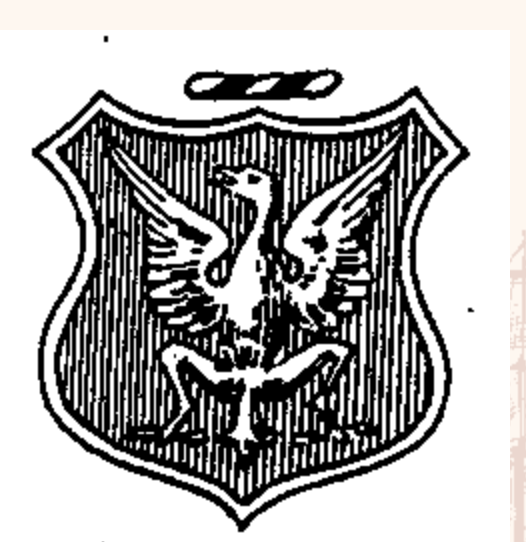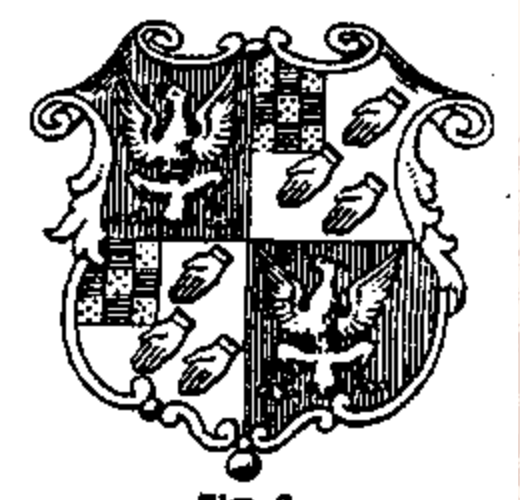Coat of Arms

The Cushings of Norfolk were entitled to bear arms for many successive generations through their holding the manors of Chosely, Hardingham, etc. The original arms of the Cushing family were undoubtedly "gules an eagle displayed argent". These were the arms of Roger Cossyn, William Cusseyn and others until John. From this all the others have been derived. Later, by a marriage with an heiress, the arms were quartered. In the year 1563, in which the marriage is given of John Oldham, Shimpling, of Norfolk, with Elizabeth, daughter and heir of Francis Cushin of Hingham, Norfolk, the Cushing Arms are described as follows: — "Gules, an eagle displayed argent; quarter ing, gules, three right hands torn from the wrists, a canton chequery or and az."
From this all the others have been derived. Later, by a marriage with an heiress, the arms were quartered. So far, it has been impossible to identify the family from which this quartering was derived. The marriage probably occurred some time about 1500. In the Heraldic Visitation of the County of Norfolk, England, made in the year 1563, in which the marriage is given of John Oldham, Shimpling, of Norfolk, with Elizabeth, daughter and heir of Francis Cushing of Hingham, Norfolk, the Cushing arms are described as follows :-" Gules, an eagle displayed argent; quartering, gules three right hands torn from the wrists, a canton chequery or and az." Based on this description, which is obviously slightly indefinite as regards the position of the hands, we have the following form.

First, that given as a frontispiece to this volume and considered by the writer as most authoritative. This is the form advocated by the late H. G. Somerby of England as the result of several years research in the records and deeds of Norfolk County, and it is quoted in the Register of the New England Historical and Genealogical Society. As to the position of the hand behind the canton, when not otherwise expressly specified three hands would be placed two in chief and one in base, and a canton used to be placed on a shield without altering in the least the arrangement of the original emblem.
Summary of Dr Tony Porter’s analysis of JS Cushing’s 1905 work
Sources to look at
Extracted from JSC
Hugh was alive in 1060 and had several sons who “accompanied William the Conqueror”. This is not supported by Complete Peerage which lists all W the C’s companions. But the Appendix lists Ralph de Tooni as a companion. Ralf de Toesni and Ralf di Limisi are in Domesday as Holders of Lands in 1086.
Hugh said to be brother of Roger. Complete peerage doesn’t mention Hugh, but mentions several other possible children of Ralf.
Marriage of Ralf di Limisi to Hadewise: Ralph de Toeni’s wife Isabel had a sister in law called Hawise. Ralph de Toeni was at Hastings but what about Ral;ph de Limisi- supposed nephew of Wthe C, through his mother, who was (JSC) Wthe C’s half –sister- but no source for this. see Burke’s peerage for comment on ancestry of the Tony family and possible connections through Hugh to Malahjulc then to Hrolf Nefja Jarl- but all unconfirmed.
JSC asserts Ralf de Limisi granted Barony of Oxburg or Oxenburg by W the C +41 other manors, with the lands of Christina, one of the sisters of Prince Edgar, whom Ralf married. Domesday in Vol II of Victoria above for Norfolk, has various mentions of Ralph in Suffolk, but also mentioned in Warwickshire, and Oxfordshire.
Christina dr of Prince Edward and Gdr of King Edmund Ironside thence back to King Alfred. No mention found of her marriage except in JSC
Heraldry: Complete Peerage “the Warenne Group of Chequered Shields” says that they are all descended form Elizabeth of Vermandois the dr of Hugh the Great, younger son of Henry I of France.
The Cushing arms confirmed as proper in the 1563 Visitation.
Sources to look at
- Victoria History of the English Counties- individual counties, including Domesday Holders of Land chapters
- Complete Peerage
- Dugdale’s Antiquities of Warwickshire Vol 2 pp 342-3
Extracted from JSC
- Roger or Richard Cosyn, both sons of Ralf le Cusyn de Limisi, who held Choseley (between Docking and Titchwell, North Norfolk);
- Galfridus (Godfrey) Cusyn b late C13, son or Roger or Richard, possessed estates in Hard’m
- Galfridus was father or GF of William C (Cussyn or Cusseyn) b Hard’m C14.
- Ralf son of Gerard and Amy, dr of Trian de Hornelade of Bidun Limisi. Gerard’s father was Alan. Alan son of Ralf de Limisi and Hadewise.
- Ralf the elder, son of Hugh de Toesini (surnamed de Limisi or Roger of Espagne).
Hugh was alive in 1060 and had several sons who “accompanied William the Conqueror”. This is not supported by Complete Peerage which lists all W the C’s companions. But the Appendix lists Ralph de Tooni as a companion. Ralf de Toesni and Ralf di Limisi are in Domesday as Holders of Lands in 1086.
Hugh said to be brother of Roger. Complete peerage doesn’t mention Hugh, but mentions several other possible children of Ralf.
Marriage of Ralf di Limisi to Hadewise: Ralph de Toeni’s wife Isabel had a sister in law called Hawise. Ralph de Toeni was at Hastings but what about Ral;ph de Limisi- supposed nephew of Wthe C, through his mother, who was (JSC) Wthe C’s half –sister- but no source for this. see Burke’s peerage for comment on ancestry of the Tony family and possible connections through Hugh to Malahjulc then to Hrolf Nefja Jarl- but all unconfirmed.
JSC asserts Ralf de Limisi granted Barony of Oxburg or Oxenburg by W the C +41 other manors, with the lands of Christina, one of the sisters of Prince Edgar, whom Ralf married. Domesday in Vol II of Victoria above for Norfolk, has various mentions of Ralph in Suffolk, but also mentioned in Warwickshire, and Oxfordshire.
Christina dr of Prince Edward and Gdr of King Edmund Ironside thence back to King Alfred. No mention found of her marriage except in JSC
Heraldry: Complete Peerage “the Warenne Group of Chequered Shields” says that they are all descended form Elizabeth of Vermandois the dr of Hugh the Great, younger son of Henry I of France.
The Cushing arms confirmed as proper in the 1563 Visitation.
….If the suppositions inherent in the 1905 Genealogy are correct and the Norfolk Cushings are indeed the descendents themselves of the Limesi family the implications are indeed highly interesting. Since the first members of the Limesi family to reach England came with, and were nephews of William I, the Conqueror, and descendants of the Dukes of Normandy, the family’s history takes on a potentially very interesting appearance!
There is, however, an even more interesting prospect to be found within the Cushing annals. The Cushing arms incorporate a small section of blue and gold chequy. Since no objection to their arms appears to have been registered at a Herald’s Visitation recorded in 1563, and the arms were still freely used in Massachusetts two centuries later, the entitlement to the chequy, or chequered pattern, seems likely to be unquestioned. However, whether valid or not, and it seems prima facie valid within the Cushing arms, there is an exceedingly interesting insight to be found in Appendix J of Volume XII Part 1 of “Complete Peerage”.
This is entitled the “Warenne Group of Chequered Shields” and makes it quite clear that all legitimate use of the chequy is restricted to the descendants of Isabel (otherwise Elizabeth) of Vermandois, daughter of Hugh, Count of Vermand and a granddaughter of Henry I of France. Colours vary, but are usually blue and gold or red and gold. Several English descendant families are entitled to the chequy, the most prominent being the Warennes, Earls of Surrey, hence the reference to the Warenne group. The Warennes had widespread interests in Norfolk and (thoughtheir presumed familial link to a Cushing family ancestral line is not known), it can hardly surprise us, in view of the nature of the known associations in the county, that the chequy found its way on the Cushing arms.
There is, however, an even more interesting prospect to be found within the Cushing annals. The Cushing arms incorporate a small section of blue and gold chequy. Since no objection to their arms appears to have been registered at a Herald’s Visitation recorded in 1563, and the arms were still freely used in Massachusetts two centuries later, the entitlement to the chequy, or chequered pattern, seems likely to be unquestioned. However, whether valid or not, and it seems prima facie valid within the Cushing arms, there is an exceedingly interesting insight to be found in Appendix J of Volume XII Part 1 of “Complete Peerage”.
This is entitled the “Warenne Group of Chequered Shields” and makes it quite clear that all legitimate use of the chequy is restricted to the descendants of Isabel (otherwise Elizabeth) of Vermandois, daughter of Hugh, Count of Vermand and a granddaughter of Henry I of France. Colours vary, but are usually blue and gold or red and gold. Several English descendant families are entitled to the chequy, the most prominent being the Warennes, Earls of Surrey, hence the reference to the Warenne group. The Warennes had widespread interests in Norfolk and (thoughtheir presumed familial link to a Cushing family ancestral line is not known), it can hardly surprise us, in view of the nature of the known associations in the county, that the chequy found its way on the Cushing arms.